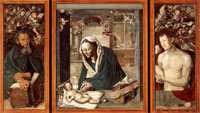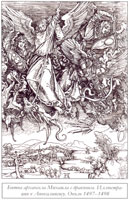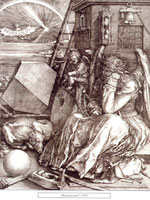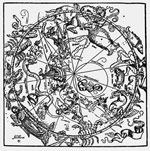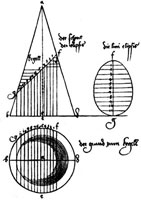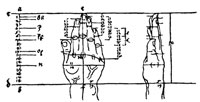Albrecht Durer. This name is always part of the extremely popular modern distributions like "hundred great artists" or even "a hundred geniuses of mankind." He was the graphic artist, painter, art theorist. He is called "the brightest star of German art", "the northern Leonardo", "outstanding master of engravings." .. and he was a scientist whose research in the field of prospect theory and geometry is relevant today.
He was born May 21, 1471 in Nuremberg - one of the major German centers of trade and crafts. His father, a well known in the city goldsmith Albrecht Dürer, Sr., dreamed that his son would inherit his business. However, the son was attracted to the workshop of neighbors - the famous Nuremberg painter Michael Wohlgemuth. Every free minute the guy tried to stay there. He watched with greedy eyes the work of the master, made friends with his apprentices, and in some ways helped them. But his father did not want to even hear about his way as a painter. He even quarreled with Wohlgemuth, saying that those allegedly draws his son.
However, Albrecht Jr. thought only about drawing. And he not only thought. His first known work - a self-portrait silver pencil, made in 1464 - when Albrecht was only 13 years old! – evidenced the great talent. It showed also that the boy already learned something- just look at how he painted the hair and folds in clothing. And it was still a long two years before his father reconciled with his son’s choice and sent him to Michael Wohlgemuth. Education was not easy: as Dürer wrote later in "Family Chronicle", "while God gave me zeal, so I was a good student. But I had a lot of suffering from apprentices." But the teacher noticed and appreciated his talent and attracted him to the work on illustrations for the book Hartmann Schedel "World Chronicle". Note that Durer not so much took over the manner of operation of the master as extremely actively studied the basics of composition and technique of painting, drawing and engraving.
It should be noted that the engraving - then still a new kind of artistic technique - with the advent of printing in the fifteenth century, spread rapidly. Martin Schongauer was the best known in the German lands master prints in the second half of the fifteenth century, and the young Durer painstakingly studied and even copied some of his work. After the expiry of the stipulated agreement three years of training he went to Schongauer. But when he came to his hometown of Colmar, the master died. After this, it was started the four-year journey of a young apprentice Albrecht Durer by Germany, Netherlands and Switzerland. In Basel, he met and, to the extent allowable differences in the age and condition, made friends with a local university professor Sebastian Brant, who just wrote his "Ship of Fools" - a book that ever entered the treasury of world culture. Albrecht Dürer was the first of its illustrator. More than 70 sheets in this series brought him recognition among the comrades in the shop and, most importantly, the realization of his skill. However, the search and training of Albrecht Durer interrupted letter from his father - he found a bride for him and demanded his son to come home immediately.
... Marriage to Agnes Frey, the daughter of a wealthy merchant and mechanics, was a marriage of convenience. Albrecht Dürer senior pinned great hopes on him: his wife had to bring his son not only dowry, but also a strong social position.
It is unlikely that this alliance was very happy. From the beginning of married life the young wife was more interested in the cost of her husband works than their art value: she took up the realization of his prints at fairs and among booksellers. However, Durer lived with his wife until his last days, although children the couple did not have. Almost immediately after the wedding, autumn 1494 because of the plague, looming over the city, he went to Italy. He left alone, because the young wife refused to go so far and remained in the country house of her parents.
The purpose of the trip of the young artist was Venice - one of the three centers of the Italian Renaissance. Here he became acquainted with the works of local artists, and sometimes copied them, tried to adopt their methods, especially in the expression of motion and complex angles of the human body, the construction of the space in the picture below or the solution of problems of color and the like. He met with the brothers Giovanni and Gentile Bellini, Giorgione still young then and Giacomo de 'Barbari, the ability which most accurately transmit the details and texture of nature depicted on Dürer made a great impression. With Barbari German artist was even able to work side by side. In a joint work, he touched more or less systematic information about the perspective and methods for image the picture plane depths of space. Perhaps it was from Barbari he heard about the geometric principles of linear perspective: it is known that the Venetian master interested in mathematics and even painted a portrait of the famous mathematician of the time - Luca Pacioli. And even then Dürer began a determined quest for solving the mystery of beauty, still suspecting that the whole thing in the ratio of the individual parts of a whole - in the proportions of the choice of which depends on the impact on the viewer and the harmony of the whole. However, Albrecht spent a short time in Italy and in the spring of 1495 he returned to Nuremberg, where he opened his own studio.
The first years of independent work brought Dürer recognition. He worked in several genres and techniques of fine arts: painting, woodcuts and engravings on copper. Soon Durer performed the first large independent work to order - the composition that in the history of art known as the Dresden altar (now on display at the Dresden Art Gallery). Portraits, written at the time, laid the foundations of the genre in German art - of which there began a slow drift toward secular subjects and the rejection of purely religious motives. The pinnacle was the self-portrait of 1500 year, in which Albrecht Dürer realized his understanding of beauty and implemented the own ideas of ideal proportions and perfect. It was unusual even by its angle view: as artists portrayed before only Christ, saints or kings - so he argued opinion by means of art the Holy letters that man was created in the image and likeness of God.
Note that the search for the ideal proportions of the human body and if the broader criteria of beauty in general have been the leitmotif of creativity Durer in the early 1500s. Creativity demanded not only inspiration, but, above all, accurate knowledge, and he tried to unravel the mystery of numerical relations harmony. First in Germany, he begun to study male and female nudity, trying to deduce the formula of ideal beauty. The result of this search was the engraving on copper "Adam and Eve" and subsequently - scenic diptych of the same name.
... The end of the XV century gave rise to rumors of similar natural disasters and the end of the world, which was reflected in the arts. There appeared at that time strange and sinister thoughts-phantasmagoria of Hieronymus Bosch, as well as a series of illustrations for "Apocalypse" made by Albrecht Dürer. These fifteen sheets were absolutely new phenomenon in the art. The artist with the help of only monochrome engraving tools reached the top and graphic expression of power. But that was not all. On the back of each print was - for the first time in history! - published in the German translation of relevant places "Apocalypse", which was done by Dürer. Bounded in a book with the addition of the sixteenth title page prints quickly were spread in Germany, and the album became the forerunner of the German translation of the Bible. The next attempt was mady later by Martin Luther. Philologists later called Durer the founder of the German literary language along with Martin Luther!...
In the autumn of 1505 he went again to Italy. Funds for the trip were given by Wilibald Pirkgeymer - Nuremberg patrician, who went down in history as one of the outstanding German humanists.
In Venice, where Dürer brought many of his prints for sale, it turned out that for the local art lovers his name is already familiar, and so well that there were craftsmen who started to forge his works. Relations with some local masters were bad enough – they envied him, especially after he was commissioned to paint the church of St. Bartholomew in German court. But after the success of multi-figure compositions "Madonna of the Rosary" (also called "Feast of the Rosary"), which he performed for the altar of the church, and the best reviews of it by famous Bellini, the detractors tied languages. Here in Venice, Dürer renewed acquaintance with Giorgione and struck up a friendship with his brilliant pupil - then a young Titian. And he was still working on the paintings on religious themes and portraits. He received from the Signoria offer to stay there forever, but rejected it. In the fall of 1506 he went to Bologna - for new knowledge. There he finally met with Luke Pacholli, which in addition to many mathematical papers wrote another treatise "The Divine Perspective". However, to learn from him Durer could not – he has not enough of the basic knowledge. In those days he bought the "Start" in the Latin translation of Euclid and started his real immersion in the field of geometry - in 35 years! According to the assumptions of some art historians, he visited Milan, where he became acquainted with the great Leonardo da Vinci. He certainly went to Rome, where he spoke with great Raphael, who was working on the paintings of Roman temples and the architect Bramante. The architect the author of the project and the head of construction of St. Peter's Cathedral.
Travel to Italy brought abundance. Dürer returned to Nuremberg in early 1507, but the glory of his successes in the capitals of art reached his hometown faster. He has received several church and private orders and created a number of these masterpieces: "The Martyrdom of ten thousand Christians", "The Adoration of the Holy Trinity" ("Landauer Altar"), "The image of all the saints," "Madonna with lily", a series of woodcuts and copper "Passion of the Christ," "Life of Mary" and many others. At the same time he carefully studied Euclid and worked in the library Regiomontanus, stay in the city as a legacy of the great astronomer. Entries that have been made at that time, later formed the foundation of the treatise on measurement and geometry.
In 1412-1413 gg. Dürer decided to write a guide for artists and a treatise on the proportions. Along with "The Book on Painting," for which he took immediately after his return from Italy, this guide was later called "aesthetic digression," and was included after ten years in the treatise "The Four Books of proportions." In those days there were created perhaps the most known for his graphic works that have been called "Workshop Prints" (ie, skillfully made): "The Knight, Death and the Devil," "Saint Jerome in His Study" and "Melancholia I". These prints are full of meanings, most of which contemporaries probably read like a book, and today we must solve. This, however, gives them additional charm. Therefore, even five hundred years it goes far the knight, whom the death was trying to stop and the devil to seduce; in a cell St. Jerome is sitting in deep thought bending over a book with winged angel. Each of these prints deserves a separate article, perhaps the book. But for lack of space we will focus only on the "melancholy I" that has for centuries been recognized, an allegory of creativity and divine knowledge.
There were times when melancholy is considered the least desirable of the four moods. However, in the Renaissance, it became identified with the artistic temperament, or rather with the creativity. Moreover, in times of Durer melancholics were begun to separate on three types: the first group includes artists and artisans, the second - people whose mind is dominated by the senses - statesmen and scholars, the third - those who have prevailed intuition - theologians and philosophers. Separation of it was probably quite arbitrary, since the engraving, which is named not just "Melancholia" but "melancholy I" depicted not only the attributes of the artist or craftsman, but also the astronomer and mathematician.
There is on the engraving a brooding genius - a noble angel (perhaps in a woman's appearance) with wings. The pensive Putto (angel) is close to him. On lap of the Genius there is a book, on the belt - a bunch of keys and two purses. Next sphere, truncated parallelepiped plane, saw, hammer, hourglass, bell. On the wall - the magic square, where the sum of numbers in each row, column and diagonal is 34. Interestingly, the number 15 and 14 in the middle of the bottom row cells form a year of creating prints - 1514! It is believed that this is the first image of the magic square in European art. Note that the properties of these squares mathematics are explored more than one century. The engraving shows a rainbow through which the sun looks at the viewer. What does it mean? Perhaps, the gateway to the country have not yet identified the truths of humanity? ..
In the same period, Albrecht Durer, in collaboration with the famous German scientists Johann Stabiae and Conrad Heynfogel created three engravings imaging maps of Northern and Southern hemispheres of the sky and the Eastern Hemisphere (Old World). Dürer star charts have become the first images of the sky in the printed book. They were made in the stereographic projection, and the figures of the constellations are made in accordance with the Greek myphological tradition. This is not only a work of art, but also extremely interesting historical development of science and evidence about the then astronomical and geographical representation.
Subsequent years Durer was actively working to implement several orders of Emperor Maximilian I The most notable among them is the grand engraving "Arc de Triomphe", dedicated to the glorification of the imperial family and the exploits of the emperor and his ancestors. Its size is 3 x 3,5 meters! It is clear that it was not possible to make a single board that size, and the engraving was performed on 192 separate boards, which several other German artists helped to cut.
The artist's work has not gone without a decent evaluation and reward: September 6, 1515 Emperor Maximilian I issued a mandate to pay Durer from the city Nuremberg treasury the annual salary of 100 florins - a pretty decent sum for those times!
Generally, Albrecht Dürer gave most of his forces to engravings. He is one of the few artists of that time who equally well worked with woodcuts, and engravings on metal, owing to jewelry training from his father. And one of the first Dürer started to work with "etching engraving" on the metal. There is an assumption that he is owned by a certain improvement of this technique, in particular the use for the manufacture of the plate before the protective coating by applying a drawing and etching system wax and lacquers, which after drying gives a firm and uniform surface. It is worth noting that after four and a half century, almost the same technology began to be used in the manufacture of printed circuit boards for radio-electronic devices! Of course, using modern development techniques applied to the plate and electronic circuits.
Mandate that granted Dürer Emperor Maximilian I, after the latter's death in 1519 the authority of Nuremberg refused to recognize, thus depriving the artist of the guaranteed annual income. Therefore, the artist was forced to go along with his wife on his confirmation to the new Emperor Charles I. And since his coronation was to be held in Aachen, the ultimate goal of this trip was the Netherlands. This trip for Albrecht Dürer became a triumphal and lasted more than a year. He was solemnly accepted in the cities, which he passed; Antwerp painters, united in a guild of St. Luke's, gave in his honor a celebratory dinner, and then the magistrate asked him to settle permanently in the city and get a hundred, as in Nuremberg, and three hundred guilders a year! However, as once in Venice, Dürer refused such an honor – saying that without his hometown he can not live.
Here in Antwerp, he became acquainted with many famous painters and other well-known personalities, including prominent philosopher-humanist, author of "The Praise of Folly" by Erasmus, who wrote a full review of the delight of his prints, and again met with Sebastian Brant. A trip to Aachen was succeed – he received the confirmation of the mandate Maximilian.
The last years of his life Albrecht Dürer spent in his hometown. He enjoyed the esteem and respect of fellow citizens - he was even elected to the parliament of Forty - the supreme self-governing body of city management. But those days were for Germany, and in general for the whole of Western and Central Europe very difficult. "95 Theses", which Martin Luther nailed in 1517 to the door of the Wittenberg Castle Church, marked the beginning of irreversible changes not only in the religious, but also cultural and political life of the people. They are worried not only with religious issues: too many accumulated problems were associated with the principles of existence of entire nations. Soon after the Peasants' War broke out, led by Thomas Müntzer with peasants and the urban poor support. Nuremberg authorities began furiously pursue supporters of radical transformations, among whom there were also students and friends Durer.
However, nothing could distract him from his daily labor. He began work on the case, which thought out a few decades - the creation of theoretical treatises, which should summarize all the great artistic knowledge and skills that he had to turn out all life. The first of these was the "Guide to measuring with a ruler and compass" (1525).
His treatise Durer conceived as a practical guide, not as a book of pure mathematics. But this book is destined to become the first German textbook on geometry. The work consists of four books in which included a definition of geometric shapes, angles, parallel lines, methods of construction of regular polygons and the like. The tasks’ solutions were accurate and original at the same time. Most of the materials placed in the manual were presented for the first time the German, like the theory of conic sections. Moreover, Dürer showed how to get a flat section of any given cone. Useful until today given is the information included in the third part of the book about drawing proportions of the letters of the Latin alphabet and Gothic. A kind of culmination on the theory and practical aspects of perspective became the fourth book of the treatise. Durer proposed in it the methods of constructing perspective images, as well as some devices and instruments for its proper to obtaine them by purely mechanical means. Mathematical methods that the author used were sourced from purely visual tasks. Note that some of the Durer’s methods later became the basis of the projective and descriptive geometry.
The work was widespread, which also contributed to the fact that it was written in the German language with a purely German using of the words and customary terms for crafts. Moreover, this book was generally one of the first works of a scientific nature, which were written in German!
Another treatise - "Four books about the proportions of the human body" - was published after the death of Durer (it was printed due to involvement of Wilibald Pirkgeymer, whom we have already mentioned) in 1528. In it Durer outlined his ideas about the figure of a man and a method that allows to change the proportion of any figure in a desirable way on the base of the geometrical proportions. These methods were nothing but the affine transformation! By the way, in this work Dürer used orthogonal (rectangular) projection - a front view and a side view, which are still used in the drawings! However, in contrast to the modern technical drawings, Dürer depicted in the diagrams human figures instead of the details of the mechanisms.
It must be noted that in his mathematical research and discoveries Durer came driven by practical needs of his art. And for a long time the results were exactly the property of artists and architects. But with the passage of time and the development of natural sciences and technical subjects they became known far beyond the professional communities and in something not lost relevance to the present day.
A little aside from these two works it stands a book Dürer "Guide to streanthen towns, castles and fortresses", published 1527. The artist took up this theme inspired by the appearance of a firearm. Its work on the fortifications, he wrote, based on the experience of numerous military campaigns witnessed it happened to be, the views and opinions of the participants Nuremberg armorers. And he also guided by his own ideas for architectural planning. These ideas were so fruitful that for two centuries they were borrowed by engineers fortifiers. For example, the rondels (he called them basteja) - large structures that were open at the top gun defenses and were well protected from the front and flanks, and can only be destroyed using mines - have been implemented in the fortress Bokar della Verona and in the fortress city in North Shafgauzene Switzerland. Dürer also include other proposals that were later used in the construction of fortifications - the type of round-Fort pledge to strengthen the square and the like.
However, until his last days Albrecht Dürer did not leave the main work of his life. As in his younger years, he worked hard on prints and paintings. His last work that he gave to his native Nuremberg, became the diptych "Four Evangelists", which is sometimes called "The Four Temperaments" - perhaps one of the highest achievements of his genius, not only for the perfection of the performance, but also the depth of design, which the author implemented in these different, but internally related figures ...
... Albrecht Dürer died in his hometown. He was buried in the cemetery of St. John. On his tomb there carved an epitaph of Wilibald Pirkgeymerom: "What was dying in Albrecht Dürer, lies under this hill. He rested on April 6, 1528". The tomb is until now a holy place for inhabitants of Nuremberg.
1. Self-Portrait, 1500
2. Dresden Altar (detail), 1496
3. Battle of the Archangel Michael with a dragon. Illustration for "Apocalypse", 1497-1498
4. Melancholy I 1514
5. Map of the southern hemisphere of the sky, 1515
6. The method of construction of the ellipse, as the cut of the cone (with the "Guide to the measurement of ...")
7. The device for the construction of perspective images
8. Men's wrist in two projections


